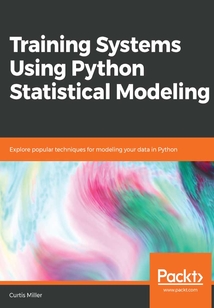首頁 > 計算機網(wǎng)絡(luò) >
編程語言與程序設(shè)計
> Training Systems Using Python Statistical Modeling最新章節(jié)目錄
舉報 

會員
Training Systems Using Python Statistical Modeling
Python'seaseofuseandmulti-purposenaturehasledittobecomethechoiceoftoolformanydatascientistsandmachinelearningdeveloperstoday.Itsrichlibrariesarewidelyusedfordataanalysis,andmoreimportantly,forbuildingstate-of-the-artpredictivemodels.Thisbooktakesyouthroughanexcitingjourney,ofusingtheselibrariestoimplementeffectivestatisticalmodelsforpredictiveanalytics.You’llstartbydivingintoclassicalstatisticalanalysis,whereyouwilllearntocomputedescriptivestatisticsusingpandas.Youwilllookatsupervisedlearning,whereyouwillexploretheprinciplesofmachinelearningandtraindifferentmachinelearningmodelsfromscratch.Youwillalsoworkwithbinarypredictionmodels,suchasdataclassificationusingk-nearestneighbors,decisiontrees,andrandomforests.Thisbookalsocoversalgorithmsforregressionanalysis,suchasridgeandlassoregression,andtheirimplementationinPython.Youwillalsolearnhowneuralnetworkscanbetrainedanddeployedformoreaccuratepredictions,andwhichPythonlibrariescanbeusedtoimplementthem.Bytheendofthisbook,youwillhavealltheknowledgeyouneedtodesign,build,anddeployenterprise-gradestatisticalmodelsformachinelearningusingPythonanditsrichecosystemoflibrariesforpredictiveanalytics.
目錄(149章)
倒序
- coverpage
- Title Page
- Copyright and Credits
- Training Systems Using Python Statistical Modeling
- About Packt
- Why subscribe?
- Packt.com
- Contributors
- About the author
- Packt is searching for authors like you
- Preface
- Who this book is for
- What this book covers
- To get the most out of this book
- Download the example code files
- Download the color images
- Conventions used
- Get in touch
- Reviews
- Classical Statistical Analysis
- Technical requirements
- Computing descriptive statistics
- Preprocessing the data
- Computing basic statistics
- Classical inference for proportions
- Computing confidence intervals for proportions
- Hypothesis testing for proportions
- Testing for common proportions
- Classical inference for means
- Computing confidence intervals for means
- Hypothesis testing for means
- Testing with two samples
- One-way analysis of variance (ANOVA)
- Diving into Bayesian analysis
- How Bayesian analysis works
- Using Bayesian analysis to solve a hit-and-run
- Bayesian analysis for proportions
- Conjugate priors for proportions
- Credible intervals for proportions
- Bayesian hypothesis testing for proportions
- Comparing two proportions
- Bayesian analysis for means
- Credible intervals for means
- Bayesian hypothesis testing for means
- Testing with two samples
- Finding correlations
- Testing for correlation
- Summary
- Introduction to Supervised Learning
- Principles of machine learning
- Checking the variables using the iris dataset
- The goal of supervised learning
- Training models
- Issues in training supervised learning models
- Splitting data
- Cross-validation
- Evaluating models
- Accuracy
- Precision
- Recall
- F1 score
- Classification report
- Bayes factor
- Summary
- Binary Prediction Models
- K-nearest neighbors classifier
- Training a kNN classifier
- Hyperparameters in kNN classifiers
- Decision trees
- Fitting the decision tree
- Visualizing the tree
- Restricting tree depth
- Random forests
- Optimizing hyperparameters
- Naive Bayes classifier
- Preprocessing the data
- Training the classifier
- Support vector machines
- Training a SVM
- Logistic regression
- Fitting a logit model
- Extending beyond binary classifiers
- Multiple outcomes for decision trees
- Multiple outcomes for random forests
- Multiple outcomes for Naive Bayes
- One-versus-all and one-versus-one classification
- Summary
- Regression Analysis and How to Use It
- Linear models
- Fitting a linear model with OLS
- Performing cross-validation
- Evaluating linear models
- Using AIC to pick models
- Bayesian linear models
- Choosing a polynomial
- Performing Bayesian regression
- Ridge regression
- Finding the right alpha value
- LASSO regression
- Spline interpolation
- Using SciPy for interpolation
- 2D interpolation
- Summary
- Neural Networks
- An introduction to perceptrons
- Neural networks
- The structure of a neural network
- Types of neural networks
- The MLP model
- MLPs for classification
- Optimization techniques
- Training the network
- Fitting an MLP to the iris dataset
- Fitting an MLP to the digits dataset
- MLP for regression
- Summary
- Clustering Techniques
- Introduction to clustering
- Computing distances
- Exploring the k-means algorithm
- Clustering the iris dataset
- Compressing images with k-means
- Evaluating clusters
- The elbow method
- The silhouette method
- Hierarchical clustering
- Clustering the iris dataset
- Clustering the Headlines dataset
- Spectral clustering
- Clustering the Headlines dataset
- Summary
- Dimensionality Reduction
- Introducing dimensionality reduction
- Uses of dimensionality reduction
- Principal component analysis
- Demonstration of PCA
- Choosing the number of components
- Singular value decomposition
- SVD for image compression
- Low-rank approximation
- Reconstructing the image using compact SVD
- Low-dimensional representation
- Example of MDS
- MDS in action
- How MDS comes into the picture
- Constructing distances
- Summary
- Other Books You May Enjoy
- Leave a review - let other readers know what you think 更新時間:2021-06-24 14:21:20
推薦閱讀
- Implementing Cisco Networking Solutions
- OpenShift在企業(yè)中的實踐:PaaS DevOps微服務(wù)(第2版)
- Hands-On Reinforcement Learning with Python
- WebRTC技術(shù)詳解:從0到1構(gòu)建多人視頻會議系統(tǒng)
- ANSYS Fluent 二次開發(fā)指南
- SQL基礎(chǔ)教程(第2版)
- PLC應(yīng)用技術(shù)(三菱FX2N系列)
- Learning Docker Networking
- scikit-learn Cookbook(Second Edition)
- INSTANT Premium Drupal Themes
- 和孩子一起學編程:用Scratch玩Minecraft我的世界
- Mastering Machine Learning with R
- Hands-On ROS for Robotics Programming
- C語言程序設(shè)計
- SQL Server 2014數(shù)據(jù)庫設(shè)計與開發(fā)教程(微課版)
- Learning RxJava
- 零基礎(chǔ)學C++
- Objective-C入門教程
- Mastering PhoneGap Mobile Application Development
- Python程序設(shè)計基礎(chǔ)與應(yīng)用
- Java開發(fā)之道
- 虛擬化工程師運維實戰(zhàn):VMware服務(wù)器虛擬化+Citrix桌面/應(yīng)用虛擬化+Veeam備份+Zabbix監(jiān)控
- MATLAB數(shù)值分析與應(yīng)用
- Java程序設(shè)計案例教程(第三版)
- Jenkins Essentials(Second Edition)
- Java+OpenCV高效入門
- Rust Programming Cookbook
- Java程序員面試筆試寶典
- Rails 4 Application Development HOTSHOT
- 馴服爛代碼:在編程操練中悟道

